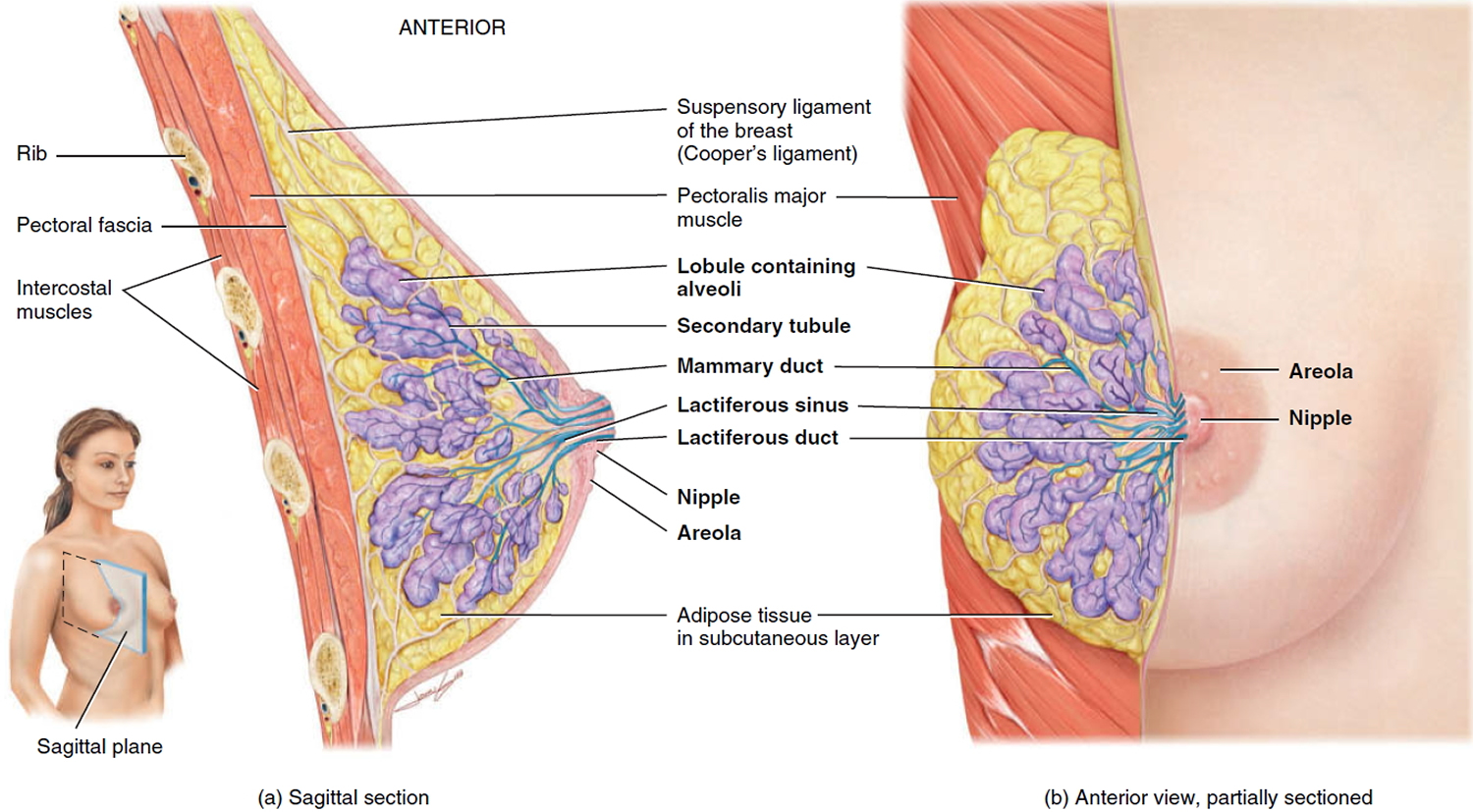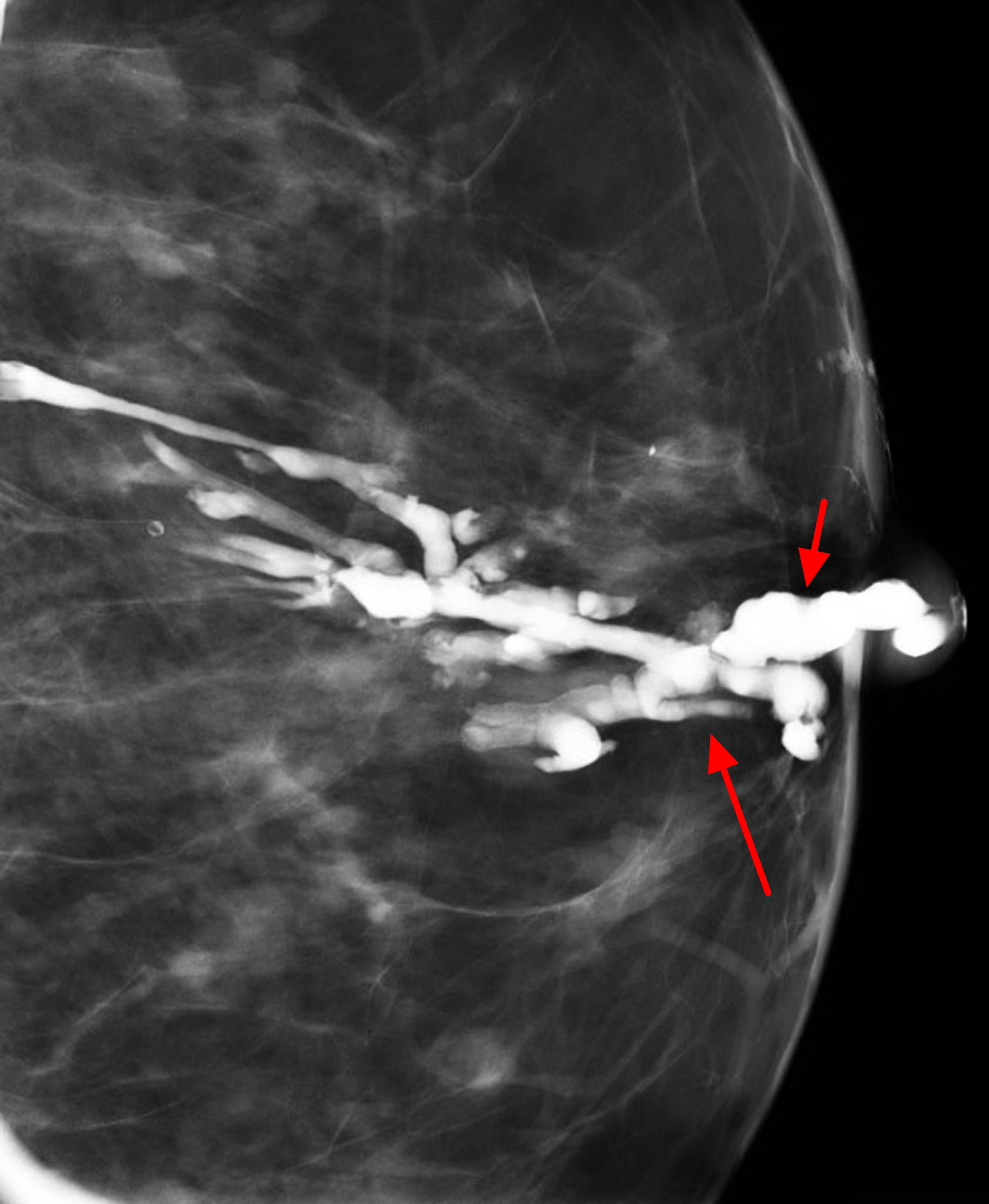Contents
What is mammary duct ectasia
Mammary duct ectasia is a breast condition in which the milk ducts (lactiferous ducts) in the breast beneath the nipple become wider (dilated), the duct walls thicken and blocked with fluid, causing nipple discharge, tender or red nipples, and inverted nipples. The milk duct can then become blocked or clogged with a thick, sticky substance. Mammary duct ectasia usually causes no signs or symptoms, but some women may have nipple discharge, breast tenderness or inflammation of the clogged duct (periductal mastitis).
Mammary duct ectasia most often occurs in women of perimenopausal age — around 45 to 55 years — but it can happen after menopause, too. Very rarely seen in males. The condition sometimes improves without treatment.
Though it’s normal to worry about any changes in your breasts, mammary duct ectasia and periductal mastisis aren’t risk factors for breast cancer.
Occasionally, mammary duct ectasia presents with similar clinical features to those of breast cancer 1. For example, mammary duct ectasia often presents with an atypical and insidious mass without inflammation 2, rendering it difficult to diagnose and differentiate from breast cancer 3. Furthermore, breast cancer may be confused with benign lesion in imaging, particularly inflammatory cancer, which had an incidence rate of between 1 and 6% in the United States between 1988 and 2000 4 and resembles mammary duct ectasia and breast abscess 4. Therefore, it is important to differentiate between mammary duct ectasia and breast cancer for timely diagnosis and subsequent treatment.
If the blocked duct becomes infected, you may feel a lump under the nipple. Most often this condition goes away on its own and doesn’t need treatment. Your health care provider may suggest you take pain medicine; apply a warm, wet cloth to your breast; use breast pads for nipple discharge; and/or take antibiotics. If symptoms persist, you may need surgery to remove the affected milk duct.
Make an appointment with your doctor for evaluation if you notice changes in your breasts — such as a new breast lump, spontaneous nipple discharge or an inverted nipple — that are persistent or that worry you.
Female Breast Anatomy
Within each breast is a mammary gland, a modified sudoriferous (sweat) gland that produces milk (Figure 1). A mammary gland consists of 15 to 20 lobes, or compartments, separated by a variable amount of adipose tissue. In each lobe are several smaller compartments called lobules, composed of grapelike clusters of
milk- secreting glands termed alveoli (small cavities) embedded in connective tissue. Contraction of myoepithelial cells surrounding the alveoli helps propel milk toward the nipples. When milk is being produced, it passes from the alveoli into a series of secondary tubules and then into the mammary ducts. Near the nipple, the mammary ducts expand slightly to form sinuses called lactiferous sinuses, where some milk may be stored before draining into a lactiferous duct. Each lactiferous duct typically carries milk from one of the lobes to the exterior.
The functions of the mammary glands are the synthesis, secretion, and ejection of milk; these functions, called lactation, are associated with pregnancy and childbirth. Milk production is stimulated largely by the hormone prolactin from the anterior pituitary, with contributions from progesterone and estrogens. The ejection of milk is stimulated by oxytocin, which is released from the posterior pituitary in response to the sucking of an infant on the mother’s nipple (suckling).
Strands of connective tissue called the suspensory ligaments of the breast (Cooper’s ligaments) run between the skin and fascia and support the breast. These ligaments become looser with age or with the excessive strain that can occur in longterm jogging or high-impact aerobics.
Figure 1. Normal breast (female)
Figure 2. Mammary duct ectasia (galactogram – the ectatic duct can be followed out right onto the opening on the nipple)
Mammary duct ectasia complications
Complications of mammary duct ectasia are usually minor and often more bothersome than serious. These may include:
- Nipple discharge. Nipple discharge caused by mammary duct ectasia can be frustrating. Fluid leaking from your nipples can cause embarrassing wetness and staining on your clothes.
- Breast discomfort. Mammary duct ectasia can cause redness, swelling and tenderness around your nipples.
- Infection. A bacterial infection (periductal mastitis) may develop in the affected milk duct, sometimes causing pain in or around the nipple, a general feeling of illness (malaise) or a fever. Untreated infection could lead to an abscess — a collection of pus in your breast tissue — which may require a procedure to drain it.
- Concern about breast cancer. When you notice a change in your breast, you may worry that it’s a sign of breast cancer, especially if you develop a hard lump around a milk duct affected by mammary duct ectasia. While it’s important to get signs and symptoms checked out promptly, remember that mammary duct ectasia does not increase your risk of breast cancer.
Mammary duct ectasia causes
Your breasts are made up of connective tissues that include a system of milk ducts — tiny passages that carry milk to the nipples. Mammary duct ectasia occurs when a milk duct beneath the nipple widens, becoming blocked or clogged with a sticky substance and inflamed.
Experts don’t know exactly what causes mammary duct ectasia. Some speculate the cause to be associated with:
- Breast tissue changes due to aging. As you age, the composition of your breast tissue changes from mostly glandular to mostly fatty in a process called involution. These normal breast changes can sometimes lead to a blocked milk duct and the inflammation associated with mammary duct ectasia.
- Smoking. Cigarette smoking may be associated with widening of milk ducts, which can lead to inflammation and, possibly, mammary duct ectasia. There is a known association between ductal ectasia and smoking 5.
- Nipple inversion. A newly inverted nipple may obstruct milk ducts, causing inflammation and infection. A nipple that’s newly inverted could also be a sign of a more serious underlying condition, such as cancer.
Mammary duct ectasia symptoms
Mammary duct ectasia often doesn’t cause any signs or symptoms. If you do experience signs and symptoms, you may notice:
- A dirty white, greenish or black nipple discharge from one or both nipples
- Tenderness in the nipple or surrounding breast tissue
- Redness of the nipple and sometimes the surrounding area
- A breast lump or thickening near the clogged duct
- A nipple that’s turned inward (inverted)
A bacterial infection called mastitis also may develop in the affected milk duct, causing breast tenderness, inflammation in the area around the nipple (areola) and fever. Signs and symptoms of mammary duct ectasia may improve on their own.
Mammary duct ectasia diagnosis
Based on information you provide to your doctor and the results of a physical exam, you might need additional tests, including:
- Diagnostic ultrasound of the nipple and areola. An ultrasound uses sound waves to make images of breast tissue. It allows your doctor to evaluate the milk ducts beneath your nipple. A diagnostic ultrasound lets your doctor focus on an area of suspicion.
- Diagnostic mammography. Mammography provides X-ray images of your breast and can help your doctor evaluate your breast tissue. A diagnostic mammogram provides more-detailed views of a specific area of your breast than a screening mammogram does.
Mammary duct ectasia treatment
Mammary duct ectasia doesn’t always require treatment. If your symptoms are bothersome, however, treatment options may include:
Mammary duct ectasia antibiotic treatment
Your doctor may prescribe an antibiotic for 10 to 14 days to treat an infection caused by mammary duct ectasia. Even if your symptoms greatly improve or disappear completely after starting the antibiotic, it’s important to take all your medication as prescribed.
Mammary duct ectasia home treatment
To relieve discomfort associated with mammary duct ectasia, you might try these self-care measures:
- Apply warm compresses. A warm compress applied to your nipple and surrounding area may soothe painful breast tissue.
- Use breast pads for nipple discharge. Using breast pads or nursing pads can keep fluid from leaking through your clothing. These pads are available at drugstores and many retail stores that sell baby-care products.
- Wear a support bra. Choose bras with good support to minimize breast discomfort. A well-fitting bra can also help keep a breast pad in place to absorb nipple discharge.
- Sleep on the opposite side. Avoid sleeping on the same side of your body as your affected breast to help prevent swelling and further discomfort.
- Stop smoking. Smoking may make it harder to treat an infection, and ongoing smoking may result in recurrent infections or an abscess.
- Pain medication. You could try a mild pain reliever, such as acetaminophen (Tylenol, others) or ibuprofen (Advil, Motrin IB, others), as needed for breast discomfort. Follow your doctor’s recommendation on which pain reliever is best for you.
Surgery
If antibiotics and self-care don’t work, the affected milk duct may be surgically removed. This procedure is done through a tiny incision at the edge of the colored tissue around your nipple (areola). Surgery rarely is needed for mammary duct ectasia.
- Kim BS, Lee JH, Kim WJ, Kim DC, Shin S, Kwon HJ, Park JS, Park YM. Periductal mastitis mimicking breast cancer in a male breast. Clin Imaging. 2013;37:574–576. doi: 10.1016/j.clinimag.2012.09.004. https://www.ncbi.nlm.nih.gov/pubmed/23116730[↩]
- Duchesne N, Skolnik S, Bilmer S. Ultrasound appearance of chronic mammary duct ectasia. Can Assoc Radiol J. 2005;56:297–300 https://www.ncbi.nlm.nih.gov/pubmed/16579023[↩]
- Masciadri N, Ferranti C. Benign breast lesions: Ultrasound. J Ultrasound. 2011;14:55–65. doi: 10.1016/j.jus.2011.03.002 https://www.ncbi.nlm.nih.gov/pmc/articles/PMC3558101/[↩]
- Yamauchi H, Woodward WA, Valero V, Alvarez RH, Lucci A, Buchholz TA, Iwamoto T, Krishnamurthy S, Yang W, Reuben JM, et al. Inflammatory breast cancer: What we know and what we need to learn. Oncologist. 2012;17:891–899. doi: 10.1634/theoncologist.2012-0039 https://www.ncbi.nlm.nih.gov/pmc/articles/PMC3399643/[↩][↩]
- Rahal RM, de Freitas-Júnior R, Paulinelli RR. Risk factors for duct ectasia. Breast J. 2005;11 (4): 262-5. doi:10.1111/j.1075-122X.2005.21684.x https://www.ncbi.nlm.nih.gov/pubmed/15982393[↩]







